この文章を英語にしてください。(辞書を使ってはいけません!)
彼はバイクに乗っているけど、
彼女はリムジンに乗っている。
次のクイズは1月7日(水)です。
This site will always respect your personal information.
Entering your e-mail address will allow this form to send a copy of your answer back to you.
このコーナーは毎週水曜日です!
さぁ、変な英語を直しましょう!-
彼はバイクに乗っているけど、
彼女はリムジンに乗っている。
次のクイズは1月7日(水)です。
This site will always respect your personal information.
Entering your e-mail address will allow this form to send a copy of your answer back to you.
このコーナーは毎週水曜日です!
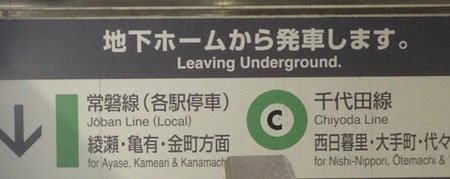
X Leaving Underground.
Tim says:
Something about this sign made me worry that I was going to miss the train. It’s leaving already?!
It would sound a little better to say “leaving from underground” or “departing from underground”. But most native English speakers (perhaps Americans in particular!) prefer to have the intended meaning stated more clearly. The point of this sign is not that the train is leaving, nor even that it’s underground; it’s that the track is below where you currently are, and that you need to go down in order to board the train. So how about:
O Go downstairs to board the train
Ayumi says:
修正案としては、1) 主語を補い、2) 動詞の形を変えて、3) underground に fromをつける。
The trains leave from underground.
ところで、日本語で「地下ホームから発車します。」と言われたら、「地下ホームに降りてください。」の意味だとわかる。「降りてください」と直接言うのではなく、間接的な表現を使うのが日本語の特徴でもあり自然なのですが、英語では違う。まどろっこしい言い方では、beside the point (的外れ) でわかりにくいと判断されてしまいます。たとえ正しい英語でも、単なる日本語の英訳だと英語としてピントがはずれてしまうこともありますね。
気をつけねば~
田中亜由美は「TOEICテスト クロストレーニング PART 1・2」などの本は販売中!ブログはこちら.
周囲にある英語を見て、果たしてそれが正しい英語なのだろうかと感じる英語はありますか?「あの英語は絶対に間違っている」という英語の表記はありますか?看板の写真を撮って、Machigai.comに送りましょう!とんでもない英語だったら、このコーナーで出します!
そのサイトでフォローしてくれたから、リフォローしてあげた。
次のクイズは12月31日(水)です。
This site will always respect your personal information.
Entering your e-mail address will allow this form to send a copy of your answer back to you.
このコーナーは毎週水曜日です!
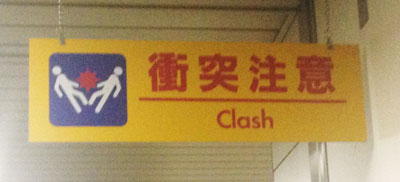
X Clash
Tim says:
I have a few theories about this very strange sign:
「衝突」in English is “collision”, not “clash”. However, “beware of collisions” is a little unclear. Perhaps we could say:
O Be careful when rounding corner
Ayumi says:
田中亜由美は「TOEICテスト クロストレーニング PART 1・2」などの本は販売中!ブログはこちら.
周囲にある英語を見て、果たしてそれが正しい英語なのだろうかと感じる英語はありますか?「あの英語は絶対に間違っている」という英語の表記はありますか?看板の写真を撮って、Machigai.comに送りましょう!とんでもない英語だったら、このコーナーで出します!
その後からずっと風邪をひいている。
次のクイズは12月24日(水)です。
This site will always respect your personal information.
Entering your e-mail address will allow this form to send a copy of your answer back to you.
このコーナーは毎週水曜日です!
 今週のよくある英語の間違い:
今週のよくある英語の間違い:
Co-host: Kei Oonuki
ポッドキャスト: 新しいウインドウで再生 | ダウンロード
Subscribe: RSS
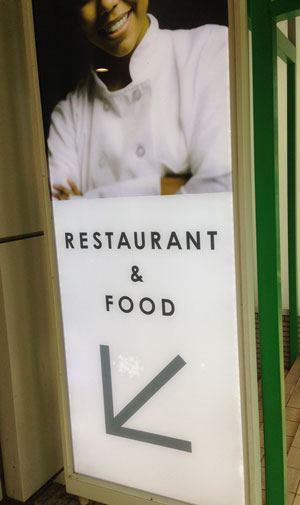
X Restaurant & Food
Tim says:
A common theme of “Sign Language” signs has been signs with two nouns that aren’t from the same category, such as “Pasta & Cafe” — a type of food and a type of establishment. (I have a collection of these photos that I haven’t yet put on the site!)
But this week’s is probably the best ever in that category, because, while the two nouns are from different categories, the sign is also redundant. A “restaurant” ALWAYS serves “food” — so why do they even need to mention it on the sign?!
O Restaurant
Ayumi says:
田中亜由美は「TOEICテスト クロストレーニング PART 1・2」などの本は販売中!ブログはこちら.
周囲にある英語を見て、果たしてそれが正しい英語なのだろうかと感じる英語はありますか?「あの英語は絶対に間違っている」という英語の表記はありますか?看板の写真を撮って、Machigai.comに送りましょう!とんでもない英語だったら、このコーナーで出します!
彼はクラシック音楽が好き。
次のクイズは12月17日(水)です。
This site will always respect your personal information.
Entering your e-mail address will allow this form to send a copy of your answer back to you.
このコーナーは毎週水曜日です!
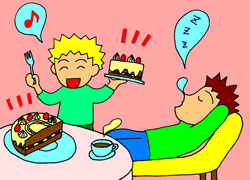 今週のよくある英語の間違い:
今週のよくある英語の間違い:
Co-hosts: Haruka Murakami and Kei Oonuki
ポッドキャスト: 新しいウインドウで再生 | ダウンロード
Subscribe: RSS
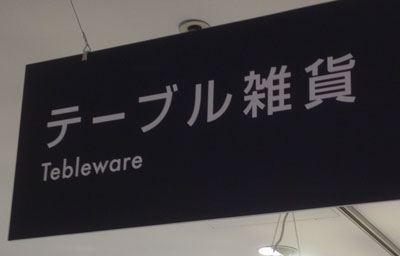
X Tebleware
Tim says:
In Japanese, it’s pronounced “teeburu”. However, the vowel used in the English spelling is “a”, not “e”! I can understand why this would be a bit confusing. But… why didn’t someone check a dictionary, before making this sign?!
O Tableware
周囲にある英語を見て、果たしてそれが正しい英語なのだろうかと感じる英語はありますか?「あの英語は絶対に間違っている」という英語の表記はありますか?看板の写真を撮って、Machigai.comに送りましょう!とんでもない英語だったら、このコーナーで出します!